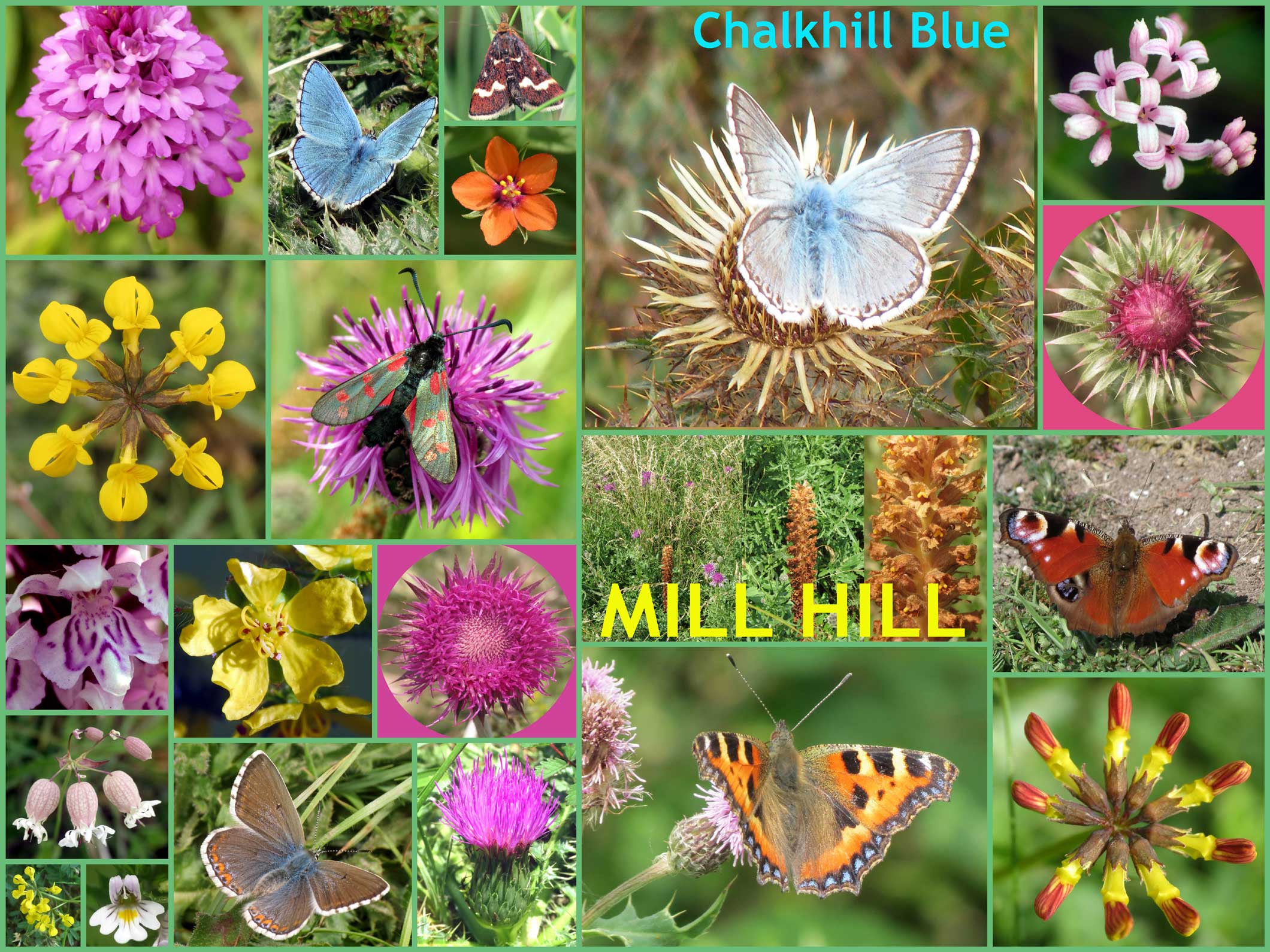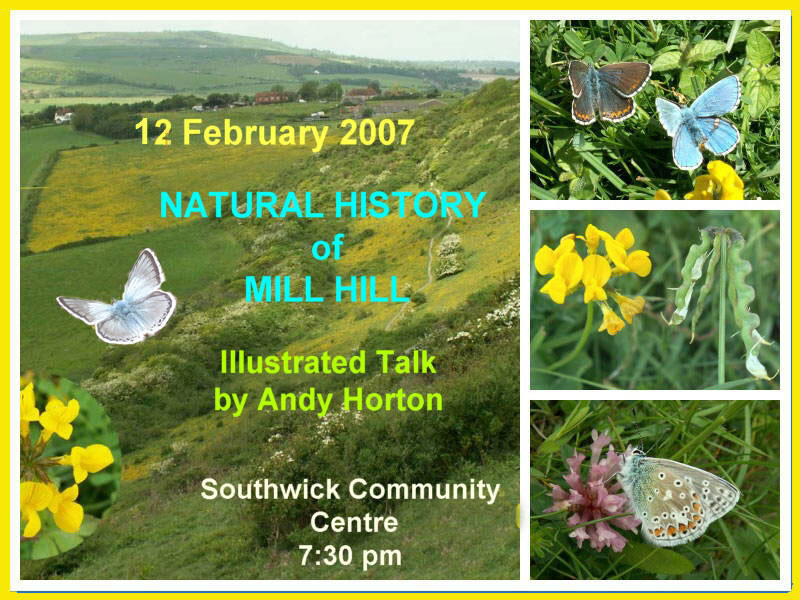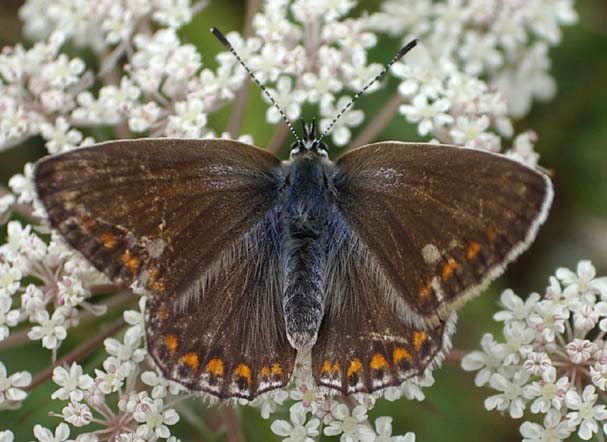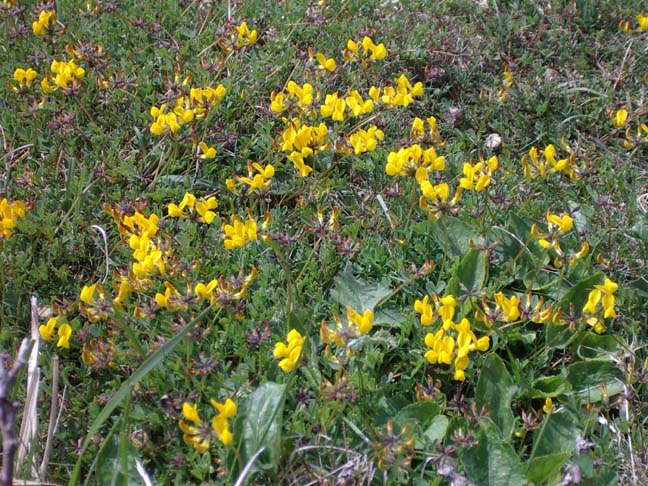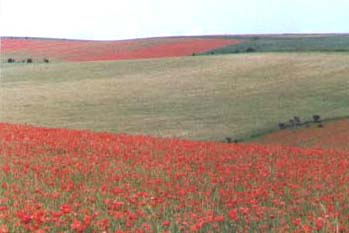 |
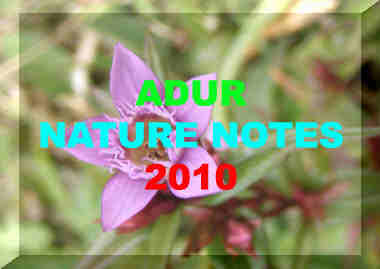 |
|
|
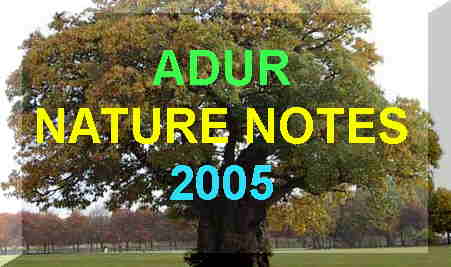 |
 |
| Lower Slopes of Mill Hill |
| Lancing Ring Nature > 2003 |
| History of Mill Hill |
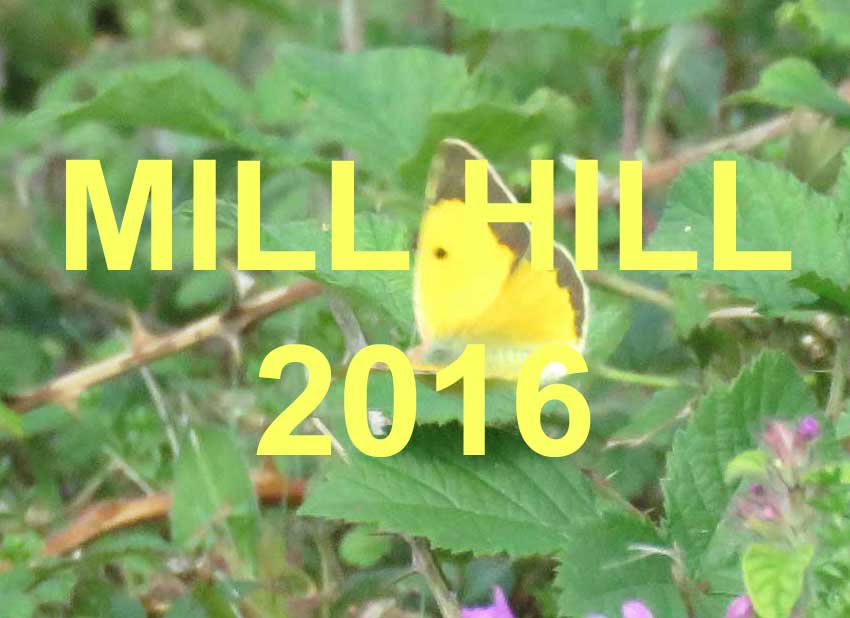 |
| Adur Flood Plain |
| Chalk Downs |
| Coastal Fringe |
| Intertidal (Seashore) |
| River Adur Estuary |
| River Adur Flood Plain |
| Sea (off Sussex) |
| Town & Gardens |
| Widewater Lagoon |
 |
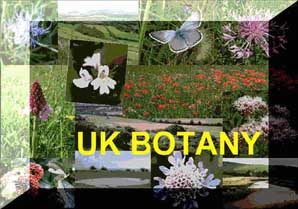 |
|
|
Shoreham-by-Sea: South Downs
Erringham Hill (arable private land) overlooking the River Adur estuary is 104 metres at its highest point. However, the Mill Hill Nature Reserve car park is near a good vantage point, 67 metres above sea level, the highest copse 92 metres, looking over the Adur Valley. Slonk Hill, NE of Buckingham Park, is 70 metres (228 feet) above sea level. Thundersbarrow is 150 metres high and Beeding Hill the high point on the downs near Shoreham is 169 metres (554 feet) above sea level. The grid reference of the upper car park is TQ 210 074.
Geographic LinkMill Hill Nature Reserve is an unimproved chalk grassland since 1937 (and almost certainly before this) of nearly 35 acres.
In 1937, Shoreham Urban District Council acquired 724 acres of downland on the east side of the River Adur, north of Shoreham, for the benefit of the people of Shoreham.
Mill Hill
Southern Car Park
12 February 2007 7:30 pm
Natural History of Mill Hill
Slide Show and Talk by Andy HortonVenue: Garden Room, Southwick Community Centre, West Sussex
(TQ 244 053)
Organised by the Southwick (Sussex) Society
Chalkhill Blues:Mill Hill is nationally important because of its population of Chalkhill Blue Butterflies. Estimates of the numbers are notoriously inaccurate. In the 1950s the population was estimated by R. M. Craske to be 50,000. This may be an exceptionally good year. I would estimate the numbers at that time to be nearer 25,000 for Mill Hill only. After the cattle grazing and thorn incursions the numbers plummeted to the most reliable estimate in 1960 of 6,000. The new road and Sycamore woodland further denuded the Horseshoe Vetch and bare chalk downland to a figure I have estimated at a top figure of 3,000 Chalkhill Blue Butterflies at the turn of the millennium (counted in 2003). Almost all these butterflies are now to be found on the six acres of the lower slopes.
Chalkhill Blues
Mill Hill contains many wild flowers characteristic of chalk herbland including:
Bird's Foot Trefoil Lotus corniculatus Dwarf Thistle Cirsium acaule Greater Knapweed Centaurea scabiosa Eyebright Euphrasia sp. Field Scabious Knautia arvensis Round-headed Rampion
Phyteuma orbiculare Small Scabious Scabiosa columbaria Horseshoe Vetch Hippocrepis comosa Carline Thistle Carlina vulgaris MILL HILL NATURE RESERVE (New Page 2004)
This page includes a new improved map of Mill Hill and the surroundingsCycling Route to Mill Hill
Lancing Ring
WILDLIFE REPORTS
Link to Wildlife Reports 2017 et seq.
15 December 2003
Small areas of the scrub on the middle slopes in the north-east corner have been cleared of vegetation including the instrusive Dogwood in the area I have christened as the Triangle. I saw one solitary small Violet flower on the lower slopes and one small tree nearby provided home for a common woodland toadstool, possibly the parasitic Honey Fungus, Armillaria. This is a pest species. Both the copse on Mill Hill and the surrounding scrub seem to have exiguous autumnal fungal life of the interesting and noticeable kind.
Honey Fungus Armillaria Copse on Mill Hill (New Web Page)
12 December 2003
As the low lying mist shrouded the copse at the top of Mill Hill, 500 Black-headed Gulls filled the air over the large field to the east, the gulls following the herd of cows that trodden three large muddy patches covering over an acre since I last visited the hill at the end of November.25 November 2003
Buffeted by the breeze, the expected Kestrel hovered over the lower slopes. After 50 mm of rain in the last three days, the grass was green and the paths muddy. The upper part of the lower slopes just below the ridge was thick with rabbit faeces. So thick, that if I wanted to sit down on the short wet swards of tufty grass, it would have near impossible to find a bit that has not been used as a rabbit latrine.With the leaves having been blown off of most of the broad-leaved trees, the photograph of the Mill Hill copse above can be contrasted with the
October photograph below and compared to the March image.
The tall evergreens are Corsican Pines.6 -10 November 2003
Forage Harvesting
The grass has been cut and bundled up into bales on the southern area of Mill Hill. These bales of mixed grasses are probably unsuitable for animal feed because of the possible Ragwort component. The long grass area immediately south of the reservoir has been left untouched.
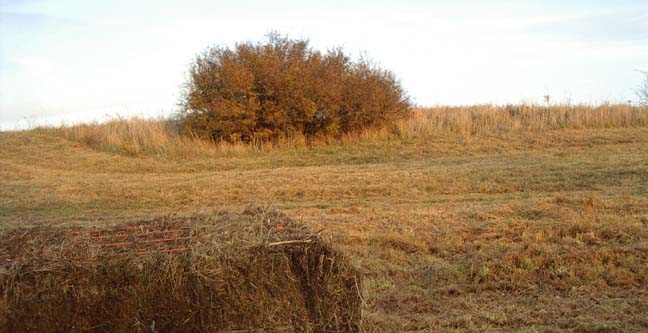
The long grasses around the upper car park have also been forage harvested. Some of the woody scrub in the far north-east corner have also been cut down allowing a view over Old Erringham Farm. The Dogwood and Wild Privet has not been tackled yet. (Should these shrubs be dealt with before they distribute their berries and seeds?) Oil Seed Rape plants are growing on the middle slopes in an eroded area where the scrub has been uprooted.
Chapel at Old Erringham (Photographs)24 October 2003
The recent cold day on 22 October 2003 has sent all the warmth-loving butterflies into hibernation. The afternoon on Mill Hill was sparse for wildlife with just the resident Magpies and a few Black-headed Gulls flying over, the only sign of movement, although a couple of Grey Herons were noteworthy in the horse's field south of the A27 bypass.I went up the hill to capture the autumn colours of the planted copse
at the top of Mill Hill, just north of the upper car park.
A selection of three commoner leaves are illustrated above.British Trees
UK Botany (Yahoo Group)21 October 2003
On a sunny midday, there was nothing of note around except that a late Wall Brown Butterfly fluttered by, landing briefly on the scrubby area of the middle slopes.17 October 2003
In the clear morning light I had another distant view of the "bird of prey" I saw a couple of days ago. The light was better and I really now think it is most likely a female Kestrel (which I thought it was in the first place). However, it still was a dark chocolate brown in colour, still seemed about to hover, but never did so, and spent part of the time chasing small birds amongst the bushes (which Kestrels do in autumn). The disposition of the tail in flight was Kestrel-like and the light underwing as well.There was a prolonged view of two Roe Deer (without antlers), one deer larger the other, skirting the fence and scrubby hedgerows/stream in the field on the levels immediately to the west of the lower slopes of Mill Hill.
16 October 2003
There were a pair of Stonechats amongst the Hawthorn as I looked down from the ridge on to the steep slopes below. A Clouded Yellow Butterfly fluttered by. In the copse at the top, there were a few Common Darter Dragonflies, some with grey abdomens.15 October 2003
Its caw (call) was a cross between that of a Magpie and a Crow, but it looked more like an overlarge Thrush or Blackbird: a couple of Ring Ouzels, Turdus torquatus, looked a very dirty black with a white breast as they chose Hawthorn bushes ahead of other shelter on the lower slopes of Mill HiIl. According to the Shoreham & District Ornithological Society 1988 "Birds of Shoreham" the peak month for migrating Ring Ouzels is October.A hawk was perched for at least a few minutes on another Hawthorn bush that stood out amongst the clump of scrub that forms and extensive border of Mill Hill with the field on the western side further down in the Adur valley. This dark brown raptor was partially silhouetted in front of the low sun. Suddenly, it took off and descended Wagtail-like and disturbed a couple of small birds in the stubble field below. Later, presumably the same bird, was seen in a low level (two metres above the sloping ground) glide and wing tilting, showing off the white underside with a large amount of dark edging to the wing-tips, before it landed in another small Hawthorn at the top of the ridge. This raptor could be a female Merlin, Falco columbarius. According to the Shoreham & District Ornithological Society 1998 Report at least eight Merlins were recorded in the local Adur district area.
I now think it is probably a Kestrel afterall (17 October 2003).
Merlin (juv.) Image (from Cheshire)In the scrub, there were plenty of rustlings (as usual), and twice the source was discovered to be foraging Blackbirds. Skylarks were in the air.
Landing on the grazing fields north of Erringham Hill, to the east of the road, an exceptional flock of over 200 Carrion Crows descended, their black forms spread over several acres. A Kestrel flew over, hovering briefly.8 October 2003
About 50 Common Darter Dragonflies, Sympetrum striolatum, and at least a couple of Migrant Hawkers, Aeshna mixta, were seen on the approaches to (25+ on the footpath from the Waterworks Road) and on the lower slopes of Mill Hill in the early afternoon. There were a handful of butterflies about.
Butterfly Report
Adur Dragonflies24 September 2003
Still the summer lingers on, but the temperature of 17.1 ºC on a sunny day falls below 20 ºC, as expected in the final quarter of the year.
Fresh Wall Brown Butterflies some put in an appearance on the path down to the lower slopes of Mill Hill. The small moth-like brown flying insects were discovered to be small female Common Blue Butterflies and there were larger male Common Blues as well. One Small Heath settled with its wings closed and then a handful of Meadow Brown Butterflies were identified. By the stile that leads on to the overgrazed land, three Clouded Yellow Butterflies danced around each other, and I was pleased to see a large party of ramblers on this footpath which is so often blocked by cows. The return journey produced a Red Admiral Butterfly and a Large White followed by a Small White Butterfly.
From the Privet and Bramble patch in the lower centre, a blue male Emperor Dragonfly rose suddenly, and there were a handful of dull brown Common Darter Dragonflies.17 September 2003
A Merlin was seen on Mill Hill. It flew at speed over the crest of the hill where at the southern end car park just past the flyover bridge at the southern end of the hill and it continued flying eastwards. A Merlin flies in a very special way skimming through the air like an arrow - it is a mini Peregrine in all respects - they prefer to grab Meadow Pipits and Skylarks rather than hirundines.
The smallest bird of prey is classified as "scarce" and a Winter Visitor and Passage Migrant in Sussex.
SOS Birds of PreyReport by Richard Ives on the Sussex Ornithological Society News(This report is interesting as I thought I saw a small fast flying hawk a few days earlier in almost exactly the same circumstances, but I was not experienced enough to be sure. I also saw a similar bird flying westwards over the airport a few days after this.)14 September 2003
A mating pair, the dark blue male Emperor Dragonfly in tandem with the emerald green female, was a magnificent sight as they flew rapidly up the lower slopes of Mill Hill and quickly disappeared. This may have been a Southern Hawker (hindsight). The scores of House Martins all seemed to be flying from west and east up from the Adur valley on to the downs to the north of Shoreham.
A pair of Wall Brown Butterflies chased each other on the ridge, south of reservoir.
Full Report7 September 2003
Just one female blue butterfly was spotted briefly on the lower slopes. It had a plain chocolate brown upper wing, but I still cannot be sure if it was an Adonis Blue or a Chalkhill Blue, despite managing a photograph.
Image and Full Report30 August 2003
On the Saturday of Shoreham Air Show, Mill Hill was closed to cars so there was only about a hundred people on the hill at one time, and apart from a couple of blackberriers, and one dog walker, the parched lower slopes were empty. The first blue was the bright blue of the Common Blue Butterfly, but the Adonis Blues soon appeared and the final count was 25. It was easy to get the species mixed up as the female blues that had orange spots on the upper hindwing (see the photograph on the right) were Chalkhill Blues. There was at least one Chalkhill Blue in pristine condition, but all three species of blues were about in the same numbers, but Common Blues and Chalkhill Blues were mostly worn and battered, with one third females.
One puzzle was a brown butterfly that looked exactly like a Brown Argus. There was no hint of white roundels on the upper wing and was just like the specimen seen and photographed on 23 July 2003 with orange spots neatly arranged on both the upper wings. There just a hint of blue colour, if anything less than shown in the photograph below (click on this text). (Alas this butterfly flew off when disturbed by what looked like a female Chalkhill Blue.) A Clouded Yellow Butterfly flew from north to south late in the afternoon.
Full Report
Blue Butterflies of Shoreham
Egg stages of the Common Blue ButterflyOn the upper slopes, the dried and parched grasses did not support the usual number of butterflies, just a handful of both Common Blues, Meadow Browns, and a few Small White Butterflies and Small Heaths. South-west of the bridge over the A27, a Wall Brown had a mid-flight contention with another one of its own species or a mistaken courtship with a Meadow Brown.
(There was a complete absence of Small Tortoiseshell and Gatekeeper Butterflies.)22 August 2003
In the copse north of the car park, an Emperor Dragonfly showed a brief predatory interest in a fluttering Speckled Wood Butterfly. Just a dozen male Adonis Blue Butterflies were counted on the lower slopes. Scrub encroachment by Dogwood on the upper slopes is occurring quicker than it is being managed.
The Triangle
20 August 2003
The second brood Adonis Blue Butterflies are now out and flying around in their brilliant blue on the lower slopes of Mill Hill. One even ventured up amongst the the brambles and long grasses immediately south of the reservoir on the upper slopes. The count was 25+ (all males) and I was careful to avoid counting the same butterfly twice and to exclude the couple of dozen Common Blue Butterflies in the total. The Small Heath Butterflies exceeded a hundred mostly on the lower slopes, but also extending on to the ridge in the only area explored south of the reservoir. The 30+ Chalkhill Blues on the lower slopes looked old, worn and battered. The Carline Thistles were popular feeding plants.
Full Report
Adur Butterflies Flight Times (incomplete)
Butterfly List
History of Mill Hill15 August 2003
I arranged to meet Andy Gattiker of the South Downs Conservation Board (SDCB) on Mill Hill. The SDCB were attempting a public consultation to justify their management decision to introduce a winter grazing of Limousin/Angus cross beef cattle on Mill Hill. The grassland was very parched with few butterflies in flight.
With the meadows all dried out the extent of the Dogwood intrusions could be seen and were pointed out to me. I still cannot envisage that short duration cattle could make many inroads into this serious problem on the middle and upper slopes. Many of the grassy glades on the middle slopes had been overgrown in the last two years.
I noticed a few Harebells on the exposed plantain wind-blasted middle slopes.
The Ragwort in the cow's field to the east of Mill Hill, has now been removed.
Full Report including Butterflies7 August 2003
My first Clouded Yellow Butterflies seen on Mill Hill this year, flew strongly over the lower slopes. There were at least three, possibly five of these bright yellow immigrant butterflies.
Full Report
30 July 2003
On an overcast, cool, with brief sunny spells, light rain at times, it would be thought of as unpromising day for butterflies. However, the whole of the lower slopes of Mill Hill were alive with the amorous flutterings of an estimated 2,000 + Chalkhill Blue Butterflies reaching densities of three every square metre (two males and one female) on plenty of occasions. The lower slopes cover nearly five acres of ground so the estimate is a conservative one. This year, the numbers must approach the historic records of thousands of Chalkhill Blues reported in the past. The last time they were described as abundant was in the hot dry summers of 1996 and 1997. (Historic: the record of 5,000 on Mill Hill in 1960 is comparative, but numbers have been recorded as lower since then.)
Altogether on Mill Hill and its approaches there were seventeen different species of butterflies, a new record in one day for me. An unusual second brood Dingy Skipper was recorded on the lower slopes. I was unable to confirm another record of a Brown Argus on the A27 bank south-east of the bridge to Mill Hill (at the top of Chanctonbury drive, north side). Common Blue Butterflies (100+) were found mostly to the south of the A27.
Butterfly List (Species Recorded)
Blue Butterflies of Shoreham
Adur Butterflies
28 July 2003
On the town side of the bridge leading to Mill Hill that transverses the main A27 road, on the east there is a small Hawthorn copse (at the top of Chanctonbury drive, north side) leading to the grasses of the trunk road steep bank. In this small garden sized plot of long grasses and scrub, two species of blue butterfly congregated sometimes fighting over the same grass head. On this cool, overcast and windy day, the commonest Common Blue Butterfly (20+) seemed very small compared to at least one, probably three or four of the larger Chalkhill Blue, together with Meadow Browns (6+) and Gatekeepers (3+). I originally thought that Brown Argus Butterflies were present but the distinctive brown-blue-brown colour is now probably the female Common Blue Butterfly (6+) as closer examination of the photographs seemed to indicate the latter butterfly.
Fourteen different species of butterfly were seen on Mill Hill.
Identification Notes about the Brown Argus
This area contains Bramble, Holly, Hawthorn, Field Maple (probably) and continuous Ivy ground flora.
Mill Hill Reports with Brown Argus Butterfly (by Lawrence Holloway)
Female Common Blue Brown Argus Mill Hill proper added extra species in Red Admirals (2+), Painted Ladies (5+), Wall Browns (6+), Small Heaths (4+), a Marbled White, a Holly Blue (by the garden hedge just north of the bridge), a least two of the reddish Small Tortoiseshells and more Chalkhill Blues (40+).
Approaches to Mill Hill Report
Butterfly List (Full Report)
Adur Butterflies23 July 2003
About fifty Common Blue Butterflies roosted on a small clump of Cocksfoot in the north-west corner of the horse's field at the top of the Street, Old Shoreham, by the footpath to Mill Hill. Nearby a Chalkhill Blue basked in the heat of the intermittent sun, with the omnipresent Gatekeepers and Meadow Browns. In the butterfly copse (near the Waterworks Road) (TQ 209 063) a Magpie Moth made a brief appearance.Marbled Whites (10+) were still present on the upper slopes with visiting Painted Ladies (12+) and Chalkhill Blues everywhere. I only counted about fifteen as my visit was fleeting, just passing through. Only nine of the fifteen butterflies of the day were to be found on Mill Hill this time.
The melody of Skylarks was in the air.
21 July 2003
Fifteen different species of butterflies in a single day (all on Mill Hill and its approaches) is a new record for me and included 200+ Chalkhill Blues on the lower slopes of Mill Hill. This list originally included the first Brown Argus Butterfly recorded on these Nature Notes, but this record is now thought to be doubtful and more likely to be a female Common Blue. An Emperor Dragonfly was on patrol in the copse.Chalkhill Blue (200+)
Meadow Brown (100+)
Gatekeeper (90+)Large Skipper (15+)
Common Blue (10+)
Red Admiral (4+)
Large White (3+)
Painted Lady (2+)
Wall Brown (2)
Marbled White (2+)
Small Heath (1+)
Small White (1+)
Small Skipper (1+)
Speckled Wood (1)
Comma (1)
Brown Argus (1) ENTRY REJECTED
20 July 2003
Early Evening
I returned to Mill Hill in the early evening and I was surprised that on the lower slopes, the abundance of Chalkhill Blues seen at midday was simply not on view any more. There were still plenty of Chalkhill Blues around but I only counted about thirty and most of them were hidden and only rose into flight because I disturbed the ones hiding in the grass. On the approaches to the Vetch Trail from the south a handful of Wall Browns left the chalk path and half a dozen 6-spot Burnet Moths buzzed around the Knapweeds. There were a handful of Speckled Wood Butterflies in the scrub, Meadow Browns (including some nymphalid-sized overlarge specimens) and Gatekeepers everywhere. On the middle slopes, in the long grass just to the south of the reservoir, there was one Marbled White resting, looking past its prime, and to my surprise in a small garden plot area, I spotted about sixty Chalkhill Blue Butterflies resting on the stems of the grasses in a manner reminiscent of Common Blues.
(*The Wall Brown Butterflies preferred the area near where the stile was, and in the long grasses including Cocksfoot south of the reservoir, and as far north down the chalk trail as the Wayfaring Tree, and Hawthorn where the scrub can overgrow the path.)Midday
Over 300 Chalkhill Blue Butterflies were observed fluttering around and copulating on the lower slopes of Mill Hill and they were to be seen on the sunny day at a conservative average of one butterfly every two square metres. At this prevalence, I got the impression that I was constantly about to step on one. My estimate for the number of Chalkhill Blues on Mill Hill was 1,200.
Butterfly Transect MethodPhil Weller reported Marbled Whites from the long grass on the ridge. The lower slopes supported Meadow Browns (50+), Gatekeepers (30+), and Small Heaths (only one identified positively).
Butterfly List (Full Report)
Adur Butterflies15 July 2003
The best area for Round-headed Rampion seems to be the area south of the upper car park and north of the reservoir on the ridge. Marbled White Butterflies (15+) and Meadow Browns (25+) were the most prevalent butterflies in the medium length grasses. There was just one Chalkhill Blue but it was early evening and the Meadow Browns (50+) were more numerous in the hedgerows and scrub.
The large grazing field immediately to the east of Mill Hill is now full of Ragwort and thistles.
Middle Slopes Images11 July 2003
The most scenic walking route to Mill Hill is from Old Shoreham, following the footpath up my horse's field accessible from the top of The Street or from the Waterworks Road, where a Teasel towering well over two metres high was spotted. Butterflies were too numerous to list by numbers and location, but there were scores of Meadow Browns, Gatekeepers, Small Skippers, Large Skippers, Marbled Whites, Large Whites, Painted Ladies and at least two Small Tortoiseshells. As I followed the path down to the lower slopes a bright yellow butterfly caught by eye. It flew on rapidly and it was a resident Brimstone.
Chalkhill Blue Butterflies quickly appeared and I stopped counting a fifty. They were flying about and not settling for long. Only a handful were on the middle and upper slopes. Amorous Speckled Woods were amongst the scrub, in dozens and probably more. Female Meadow Browns were amongst the thistles and nettles and heavy understorey vegetation. These have more orange on them than the males. On the upper slopes more Marbled Whites were evident and the red buzzing insects were 6-spot Burnet Moths, Zygaena filipendulae.
Dwarf Thistle Female Meadow Brown
(sometimes known as Hedge Browns)The Dwarf Thistle was in flower, that prickly rosette that is a characteristic and slightly uncomfortable feature of the chalk sward. In the middle of the day the miniature Eyebrights open up and are ideally viewed through a magnifying glass. Pyramid Orchids were frequently seen in the central area known as the Triangle and these orchids are found all over the hill.
Adur Butterflies
Vetch Trail Details (Chalkhill Blue etc.)
On a sunny day the temperature peaked at 26.6° C.
3 July 2003
On a humid and overcast day, the first butterflies appeared near the reservoir that separates the southern part of Mill Hill with the more interesting northern section (see map). Marbled White Butterflies (20+), Meadow Browns (20+) and my clear sighting of the Gatekeeper in the shade of a Hawthorn, was my first of the year. Later, in the long flowery meadow just south of the copse, a pristine Gatekeeper briefly opened its wings to show what a beautiful butterfly the new ones can be. Alas, it did not spread its wings long enough for a photograph.
The Triangle24 June 2003
A quick walk from the footpath (overgrown vegetation has been cut) from the Waterworks Road to Mill Hill and it was not until I reached the downs that the first few butterflies appeared. The first one I saw was a Meadow Brown and as walked along where the ridge drops off down the short turf slope I counted 25+ Small Heath Butterflies. It was in the long grass, with flowering Greater Knapweed and scores of Pyramid Orchids, between the car park and the copse on both sides of the "All Terrain Trail" that Meadow Brown Butterflies (30+) were mostly resting but easily disturbed and into flight.
The Marbled White Butterflies (11+) were freshly out and looked very bright. There must be females because two males were competing for the attentions of the female amongst the long grass. Perhaps, the most amazing observation on the ridge were a hundred or more chysalids of the 6-spot Burnet Moth (pic) on long grasses and Greater Knapweed. The early chrysalids were silver some turning straw-yellow, which happens just before the moth emerges. There were a handful of Small Tortoiseshell Butterflies, at least three Large Skippers, just one male Common Blue Butterfly seen, and a Red Admiral seen near the road bridge.
With help from Brianne Reeve
15 June 2003
Early afternoon brought the first Meadow Brown Butterflies (10+) noticed immediately followed in quick succession by Small Tortoiseshells (30+), Painted Ladies (5+), Common Blues (5+), Skippers* (50+) and one record of a Brimstone near the Triangle. The orange coloured skippers were everywhere, but the Small Heaths (30+) were mostly on the steep slopes, so I would have missed most of them. The red fluttering was an early 6 Spot Burnet Moth (not a Cinnabar). The White butterflies were not omitted: they were absent.
(* I originally penned these as Small Skippers, but they are most probably the earlier Large Skippers.)
Adur Butterflies
It looks like a bumblebee, but its identification does not fit the common species, and it is half the size of a queen. A queen of another bumblebee was present and this was the Three-banded White-tailed Bumblebee, Bombus hortorum. (No photograph was taken and with hindsight, I would like to confirm this identification.)
However, the restless insect in the photograph above, discovered in the shade almost in the copse (TQ 211 075) and near a Foxglove plant at the top of Mill Hill, was the species that attracted my interest. The white tail was most distinctive. It could also halt in mid-flight in a manner typical of hoverflies and not seen in bumblebees. So it was a mimic and not quite good enough to fool me: it is the hoverfly, Volucella bombylans var. plumata.Hoverflies of Adur
UK Hoverflies Discussion Group
More Information
Adur Bumblebees14 June 2003
In the late afternoon of a fine day, it was the first Skippers (probably Large Skippers) that caught my eye. Grasshoppers in the long grass chirped (=stridulated) away. They were amongst a variety of moths, large and small, in the long grasses north of the car park on Mill Hill. There were about 15 Skippers actually seen, but others would have been hiding away.
In the "Triangle" The Dogwood threatens to take over. The yellow was Bird's Foot Trefoil that attracted the attentions of a solitary unidentified blue butterfly.
Grasshoppers of Somerset (External Link)
UK Grasshoppers and Crickets (Yahoo Group)Bird of Prey
By the stile on the border of Mill Hill public land (area overgrown with scrubbery) and the Old Erringham grazing land* (TQ 207 076), a sleek slate blue-grey raptor flew in a silent gliding arc on my arrival, and then disappeared. I was looking down on the bird of prey from above, a rather unusual viewpoint and I noticed the streamlining of the tail feathers very clearly. My first thoughts were Sparrowhawk, but this bird seemed to have a different flight pattern and seemed slightly larger than the male Sparrowhawk. This bird is very likely to be the rare Hobby, Falco subbuteo. The Sussex Ornithological Society frequency rating for the Hobby is "scarce". However, this exciting bird is increasingly being reported and numbers are rising.
(* 300 metres SE of Old Erringham Farm buildings, frequented by hirundines in summer.)
PS: The same arcing glide has been seen subsequently (September 2004) in a Sparrowhawk. Sparrowhawks have been seen in 2005 and 2006 as well.On the Vetch Trail the absence of the vast yellow expanses of Horseshoe Vetch was my instant impression. The grasses were still the short springy turf and quickly a blue butterfly fluttered by. It was an oldish Adonis Blue Butterfly and I only counted three in an small area, compared to 20+ Small Heath Butterflies, a few Small Tortoiseshells and some Small Skippers*.
Adur Butterflies4 June 2003
I walked from the Mill Hill upper car park along the lane and down to the stables at Old Erringham, a Little Owl was in its normal place in the small copse overlooking the stables but this time sat on a fence post right next to the road, otherwise just a single Hobby seen. A few Swifts, Swallows & House Martins were around the buildings and a Chiffchaff also in the copse, plus four Yellowhammers on Mill Hill.Report by Bob Kent (Lancing) on the Sussex Birds Yahoo Group
2 June 2003
Early Evening
The Horseshoe Vetch flowers have diminished and the only blue butterflies to be seen were Common Blues amongst the long grasses on the middle slopes of Mill Hill. The old railway track at Old Shoreham had already shown a handful of Painted Lady Butterflies, all faded or dull, and the numbers steadily increased on the downs until I stopped counting at 50, of which only one was in a pristine colourful condition. A dozen plus Red Admirals were also recorded in the scrubbier areas. A handful of Small Heath Butterflies were now easily recognised when a few years ago I was not so sure. They always settled with their wings closed and when open they showed a bright orange upper wing. It took Brianne Reeve to draw my attention to dozens of Common Blue Butterflies resting wings closed in a small patch of the long grass north of the car park. If the ones we saw were extrapolated over the whole area of long grasses there would have been several hundred. This emergence must have occurred today as Brianne Reeve said they were not present yesterday when the weather was showery and overcast.
Adur ButterfliesThe best spectacle was left to last as a bird with a very bright yellow breast flew out of the bushes by the reservoir. It looked like an exotic bird and it must be a male Yellowhammer, that can look as yellow as a canary during the summer.
Yellowhammer (Birdguides)31 May 2003
The Adonis Blue Butterflies have disappeared from the lower slopes of Mill Hill and the vast expanse of Horseshoe Vetch has now receded.Report by Jan Hamblett (Lancing Nature)
26 May 2003After some rainy and dull days, the sun came out again on the Bank Holiday Monday afternoon. On the on the lower slopes both male and female Adonis Blue Butterflies flew from one Horseshoe Vetch flower to another, and occasionally settled on some bare earth patches. At the top of the ridge a single Common Blue Butterfly stood out by its clear bright blue in the dense long grasses south of the reservoir. It was a fresh specimen and the clear white fringe on the blue upperside was very clear as was the orange on the underside. It was a small specimen smaller than an Adonis male. A unidentified blue butterfly fluttered by in the scrub from the Triangle down to the Vetch Trail. Bird's Foot Trefoil was in flower on the middle slopes.
Full ReportMorning
A walk on lower slopes of Mill Hill this morning through the Horseshoe Vetch meadow brought sightings of about 30 Adonis Blue Butterflies with five Cinnabar Moths and Small Heath Butterflies with five blue (probably Azure) Damselflies as well. The female Adonis Blue Butterfly in the photograph above was sluggish and crawled around and may have just emerged from its chrysalis.
15 May 2003By the early evening a few rays of sunshine cast long shadows in the early evening, but 40+ male Adonis Blue Butterflies were fluttering around from one Horseshoe Vetch flower to another on the lower slopes. I have managed to spot the deep brown of a female when the butterfly briefly opened its wings. On the middle section above the steep slopes a pair of Small Heaths were mating amongst the long grasses and there was a Wall Brown Butterfly south of the reservoir, where the stile used to be, but now it is dismantled and lying in a heap.
Blue Butterflies (Photographs 2002-3)14 May 2003
After spotting a break in the showers that have been on and off for the last four days, I made a quick walk over the lower slopes of Mill Hill, just to confirm that no butterflies were to be seen on an overcast day.
The middle slopes on Mill Hill, beneath the ridge, north of the reservoir, are full of long dense grasses which provide roosting and mating areas for some of the butterflies. I ventured on to the middle slopes by the fence, and area beneath the ridge but before the hill drops off steeply on to the lower slopes. This is a usually disappointing area where I rarely visit. Although there were scattered clumps of Horseshoe Vetch and of White Campion, long wiry grasseshad already begun to dominate the flora, and the Spear Thistle leaves reminded me of a lowland cattle pasture. One dominant grass was Bromus. A Musk Thistle was well over a metre and half tall (pic.)
Thistles of Adur9 May 2003
On the Mill Hill lower slopes (Vetch Trail) the following butterflies were spotted in order of conspicuity:
Adonis Blue 50+
(mostly males observed)
Brimstone x 2
Peacock x 2
Small Copper 4+
(my first record from Mill Hill)
Small Heath 6+
Dingy Skipper 12+
Grizzled Skipper 3+
Speckled Wood one (in the scrub)There was just one Cinnabar Moth spotted amongst other day-flying moths, in the expanse of Horseshoe Vetch and other plants in flower including a few Cowslips and Milkwort (mostly blue, some were purple: I am not sure which species?). All the plant species are indicative of a classic chalkhill meadow.
The butterfly congregations, especially the Adonis Blues were greater at the northern end of the Horseshoe Vetch slopes. No Common Blue Butterflies were spotted on the lower slopes despite a diligent search for them.
6 May 2003
A pair of Speckled Wood Butterflies flirted on the Waterworks Road (Old Shoreham) with a handful of Red Admirals on the footpath skirting the horse's field on the way up to Mill Hill. On the lower Horseshoe Vetch covered slopes visited yesterday, a few Small White Butterflies were conspicuous but it was the other butterflies that proved to be of interest.
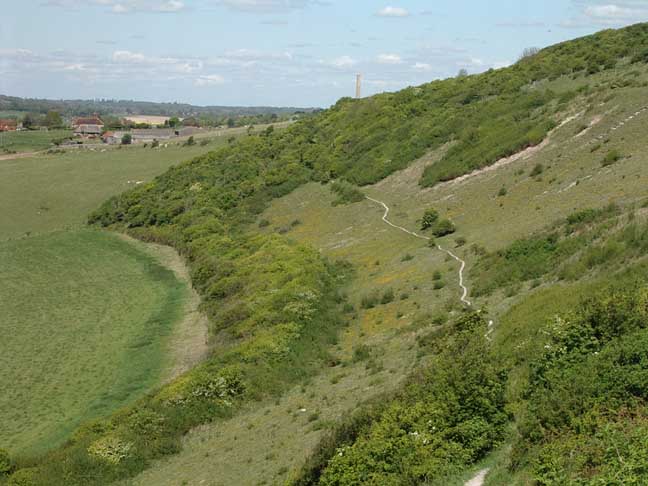
The footpath winds its way through the yellow Horseshoe Vetch
There were many more blue butterflies around, at least 30 seen, some flirting and others chasing different species off the Horseshoe Vetch flowers. I still have these down as Adonis Blue Butterflies.
The Adonis Blue is classified as a rare butterfly in Britain, although where discovered it can be plentiful. It is only found on short sward chalkhill grassland with Horseshoe Vetch its exclusive food plant for the caterpillar, and now only in about 100 sites in southern England.
Blue Butterflies Identification pageConservative numbers of the other butterflies actually seen on the lower slopes were as follows:

Grizzled Skipper 25+
Dingy Skipper 15+
Small Heath 15+
Brimstone one
Orange Tip one
(my first record from Mill Hill)
Wall Brown 4+
(on the paths between the scrub near the Triangle)
Cinnabar MothThe grass was still short and there were no grasshoppers. There were a few clumps of Red Campion on the edge of the upper ridge.
Adur Butterflies
Vetch Trail ImagesOn the ridge of Mill Hill, I enjoyed excellent views of a Kestrel, looking down on the bird as it hovered, with a chance to see its brown upper wing plumage from above.
5 May 2003
I followed the Vetch Trail on the lower slopes of Mill Hill towards Old Erringham on a sunny May Bank Holiday Monday. Several acres of the steep slopes were graced by the yellow flowers of the Horseshoe Vetch (the food plant of the Adonis Blue and Chalkhill Blue and other butterflies.) Hippocrepis comosa.The vivid blue colouring of just the one Adonis Blue Butterfly was startling as it chased away a Small Heath Butterfly from the flower of a Horseshoe Vetch. The underside wing of the Adonis was heavily pigmented with brown. The handful of Small Heaths settled with their wings closed, but it seemed that were about to open them, but they never did. One Painted Lady was a battered specimen with parts of its wing missing.
Adonis Blue Grizzled Skipper Cinnabar Moth The Dingy Skippers with at least 25 scattered over a wide area were the commonest butterflies in flight, but I saw a handful of Grizzled Skippers and the red of the single Cinnabar Moth was most striking when it fluttered around just above the rabbit-cropped low level plants.
There were Speckled Wood Butterflies and there was one Red Admiral that followed me in the dense scrub incline, or several of them.
Adur Butterflies
Vetch Trail Images22 April 2003
Although it was sunny the downs were surprisingly devoid of butterflies. Just a Speckled Wood Butterfly seen in the copse on Mill Hill and a few Small Tortoiseshells near the road. Two Herring Gulls glided over.
The Patch (Link)
More Images of Mill Hill

Field Mouse-ear, Cerastium arvense. (not the Great Stitchwort, Stellaria holostea).
ID by Richard Collingridge on UK BotanyTriangle at Mill Hill (detailed study page)A few Bluebells were in flower in the long grass south of the reservoir.
Several Dingy Skipper Butterflies were seen on Mill Hill.
Butterfly Report by Jim Steedman
16 April 2003
The shirt sleeves sunny weather was unseasonable, recorded at 21° C in the shade and this brought a few butterflies out, notable with five sulphur-yellow coloured Brimstones with a handful each of Small Tortoiseshell and Peacock Butterflies.
Dogwood, Cornus sanguinea, is growing up rapidly in the triangular area that has been cleared of scrub.
17 March 2003
Of the birds calling the melody of the Blue Tit on the lower slopes of Mill Hill, south of the by-pass was noticeable. It what is on this footpath up from the Waterworks Road that a group of three Small Tortoiseshell Butterflies, were seen and photographed and another three on Mill Hill near the reservoir.Mill Hill Images: Wildlife and Landscape
A Red-tailed Bumblebee, Bombus lapidarius, crawled out of the long grass just south of the reservoir. There was a small orange phoretic mite on its abdomen.
Adur Bumblebees
British Bumblebee Checklist
Bumble Bees
Social Bees
Parasites on Bumblebees
Classification of Acari
Distribution and Decline of British Bumblebees
Red or Orange Tailed Bumblebees
6 October 2002
The blue butterfly season is over but there were about ten Small Tortoiseshell Butterflies and an immigrant Clouded Yellow up Mill Hill, where a Wasp Spider, Argiope bruennichi, was discovered near its previous location.Report by Ray Hamblett (Lancing Nature)Ray Hamblett's Mill Hill web page (with photographs of spiders and orchids and other wild plants)
18 August 2002
A Wasp Spider,Argiope bruennichi, was spotted on Mill Hill. This a distinctive European continental species that has been spreading in the south-east.
Butterflies included 50+ Small Tortoiseshells and lesser numbers of Meadow Browns and Common Blue Butterflies, plus a Red Admiral.15 August 2002
On a hot (25° C) and humid (82%) day, I made a quick visit to Mill Hill. On a small patch of the open meadows on the upper slopes (TQ 212 073) the butterfly count for an area of 20 square metres (TQ 213 074) was high and the following species were recorded in 15 minutes:

Chalkhill Blue (60+)
Meadow Brown (35+)
Small Tortoiseshell (20+)
Painted Lady (15+)
Wall Brown (one)
Large Skipper (one) (? could possibly have been an Essex Skipper?)
Common Blue (one)
The Chalkhill Blue Butterflies were nectaring on Round-headed Rampion, Greater Knapweed and Hardheads. The Small Tortoiseshells were overlooked in passing, but when I stopped they appeared everywhere where feeding on the occasional Ragwort flower was possible. They were quick to settle and open their wings.
This a late flight of the Large Skipper (?), but it did not appear to be unduly battered.
There was a possibility of an Adonis Blue Butterfly, but this was not confirmed. It was just as likely to be a Common Blue.In the scrub and longer grasses (TQ 211 076), the Gatekeeper Butterfly was surprisingly few in number and there were a handful, possibly many more Common Blues, the females with orange markings on their upper wings, feeding on grasses. Meadow Browns were everywhere.
In the other meadows, there were additional numbers of Chalkhill Blues, Meadow Browns and Painted Ladies.
Adur Butterflies
Adonis Blues and Common Blues Identification Tips
Blue Butterflies 2001-2002
South Downs ButterfliesSkylarks were disturbed in the long grasses.
28 July 2002
To compare the butterflies on Mill Hill with the ones seen yesterday in the Lancing Clump meadows, I made a late afternoon visit and notes that the density in a smaller area was at least twice as high but the variety of butterflies, with just one pair of eyes, was smaller. Again in order of frequency, the butterflies are listed:
Gatekeeper (200+)
Meadow Brown (70+)
Marbled White (35+)
Small Skipper (25+)
Chalkhill Blue (15+)
Red Admiral
Large White
Small WhiteThere were hundreds* of 6-Spot Burnet Moths in the long grasses. (* looking at the record in 2004: could this mean over a hundred?)
The blue butterflies in the medium length grasses on the upper slopes would not settle with their wings open, on the muggy humid day, and I could not instantly confirm their identification. It is in a known Chalkhill Blue habitat and the underside has an absence of any orange so it seems that Chalkhill Blue is probable. The fringes were different from the Common Blue as well.
Blue Butterflies (Photographs 2000)The chalkhill plants were showing well, typically Eyebright, Greater Knapweed, Scabious, Pyramid Orchids, Agrimony, and Round-headed Rampion. The yellow was of the less prevalent Bird's Foot Trefoil as the Horseshoe Vetch was no longer in flower.
25 July 2002
Five Chalkhill Blue Butterflies were spotted on Mill Hill on an overcast day.Report by Derek Longhurst (Australia)
25 June 2002Amongst the bushes, there seemed to be a variety of small birds which I did not have a chance to identify. Butterflies were easier for me, and included at least one Large Skipper, one Small Skipper, only a couple of Meadow Browns on a passing quicker than usual visit. Two Red Admirals settled. One very battered butterfly had a very orange and brown upper wings, and it flew around and would not settle. It was smaller than a Meadow Brown (at this time of the the year they are usually dark) and it could have been a Small Heath Butterfly. There was a possibility of a Green-veined White Butterfly which would not settle.
Eyebrights, the small plant of the turf, were displaying well.19 June 2002
On a pleasant sunny day after a generally inclement spring, it was nearly the solstice before I made my first eventful trip to Mill Hill. Most noticeable was the field of Common Poppies grazed by a dozen or so cows between Mill Hill and Buckingham Barn, and also bright red fields to the north-east and on the ridges, highest points of the downs.
The wild flower selection was particular good with the clumps of Bird's Foot Trefoil being most noticeable, plus the other chalkland species including Eyebright, Pyramid Orchids, Greater Knapweed, Milkwort, and many others.
The strong-flying butterflies in the short grass on the upper slopes were probably Meadow Browns (5+) with additional small numbers of Painted Lady (5+) in wood groves. In the copse at the top were there was at least one Red Admiral plus a couple of Speckled Brown Butterflies, one with a wing with a large chunk missing. Small Tortoiseshell Butterflies (4+) flew around and occupied the lower, the more densely bushed area. A Burnet Moth climbed up a long grass.
29 December 2001
Snow falls before dawn and a thin layer of snow covers the pavements and from my window the downs can be seen in the murky distance covered in a sheet of white.
28 September 2001
After a spell of inclement weather with strong breezes throughout and many showers, as Brianne Reeve of Butterfly Conservation said on the walk at Lancing Ring, these conditions batter the butterflies about a lot. And it is the same exposure to the elements that helps the food plants, the abundant Horseshoe Vetch of the Chalkhill Blue, which makes Mill Hill better for these butterflies than Lancing Ring. All this meant that I was not surprised at the complete absence of medium-sized butterflies on Mill Hill, although a few Red Admirals fluttered around the copse at the top.
On the cultivated upper downs a solitary tractor cut its furrow (on the field between Mill Hill and Buckingham Barn) followed by Black-headed Gulls (200+) and Crows (40+).
On the footpath heading from Mill Hill due west immediately south of the road bridge over the by-pass (TQ 208 064), I surprised a large (one metre long) adult olive-green Grass Snake was curled up and not that quick to slither into the ivy undergrowth. The nearest streams are 200 metres away down a very steep incline. This is only the second adult snake I have ever seen in Shoreham.
Grass Snake Link
Grass Snake Photographs (Link)
17 August 2001
In the meadows amongst the scrub on Mill Hill, the Common Blue Butterfly was common (100+) clinging, wings folded, to the stems of long grasses and wild plants, to rise fluttering in the late summer evening when disturbed. This butterfly has a distinct white rim on the upperwing, lined with black on the inside and the blue is only bright when the butterfly is fluttering, when it settles and opens up the blue appears darker and strongly veined. The underside is richly patterned with ocellated spots and an orange hue, and near the abdomen/thorax the wings are distinctly bluish. The females are smaller, brown, decorated with lots of orange spots on the upperside. One Common Blue seemed to be bigger, battered with the white fringes, and the black border line absent or indistinct.
There were Chalkhill Blues as well, some a bit battered and old, others fresher, as well as the omnipresent Meadow Browns, but also some strongly flying Wall Brown Butterflies.
Blue Butterflies (Photographs 2001)
Blue Butterflies (Photographs 2000)
14 August 2001
Butterflies were unusually infrequent after a week of inclement weather. The female Chalkhill Blue (TQ 213 074) that settled nicely, seem to prefer the shorter grasslands that are cropped short by rabbits. There were a handful each of the following: Meadow Browns, Red Admiral, Painted Lady. A single Peacock settled on a yellow Ragwort flower.30 July 2001
The first Chalkhill Butterflies are on the wing on the upper slopes of Mill Hill, although they could have hatched out a couple of days before. The black veining through the white border and their appearance was the classic Chalkhill Blue. The females were very orange on the underwing. On the base of the upperside wings, the spots were very clearly visible.The Chalkhill Blues (50+) were seen frequently over a wide area but they were not at their maximum numbers and were outnumbered both by Meadow Browns (100+) and Gatekeepers (75+). Other butterflies in order of frequency were Small Whites (35+), Small Skippers (25+), Red Admirals (25+), Peacocks (20+), Holly Blue (12+), Large Whites (10+), Marbled White (one), Wall Brown (one), Speckled Wood (one), and Brimstone (one). This was my first record of a Brimstone, the wing shape is quite distinct, although I have undoubtedly overlooked them before. The Gatekeepers had clear double-spots on the underside.
South Downs Butterflies
Burnet Moths flew rapidly and did not settle.
Pictures of the Burnet Moths
Cinnabar Moth caterpillars were seen amongst the grasses on the overgrown Mill Hill paths.
18 July 2001
The Sussex branch of the Butterfly Conservation Society arranged a walk on Mill Hill in the morning. The long grasses were still soaked from yesterday's downpour. I did not make the 11:00 am start but I went up there a couple ofhours later and they were no longer around. The blue butterflies were not out yet. The only insect of note was a solitary Burnet Moth south of the car park (TQ 212 072) . It was the 6-spot Burnet Moth, Zygaena filipendulae, and it quickly flew away, the bright red most distinguishable. One of the reasons for my identification was the cocoon photographed by Ray Hamblett at the beginning of July.
Pictures of the Burnet Moths
There was a fair selection of butterflies including Small Skippers.
5 July 2001
On Mill Hill the Meadow Browns (40 +) were the commonest butterfly in the open but where the grass became longer they were replaced by Marbled Whites (40+) feeding on Greater Knapweed, and in the scrub, a handful of Gatekeeper Butterflies could be easily separated from the Meadow Browns by their smaller size and double eye-spot. The Meadow Browns would chase them given the opportunity. They remained settled for long periods with the wings folded. At first the double eye-spots could be seen, but after awhile the fawnish bit covered up the orange and the eye-spot. Large Skipper Butterflies were a bit battered but like the Gatekeeper stayed still, but with their wings open. Red Admirals flew energetically in the small copse.
Scabious and Pyramid Orchids were in flower.26 June 2001
The scores of butterflies on Mill Hill were Small Heath Butterflies (pic) and/or Meadow Browns (pic). These two species were flying strongly amongst the long grasses and I found it difficult to be 100% sure of their identification. They always settled with their wings closed and at least one did not appear to have a pair of eye-spots on the upperside of their wings.5 June 2001
On a sunny Mill Hill, above the 45° Sycamore incline from the Waterworks, butterflies fluttered around, rarely settling for more than a brief few seconds, because the largest and commonest (12 +) were the restless Wall Browns, and a single solitary Small Heath Butterfly or a Meadow Brown, the single eye spot clearly distinct on the underside from the orange. Small unidentified orange butterflies fluttered in the grasses. A female Common Blue settled. These species on the downs seem a much more robust butterfly than than those seen on the lowlands, beach margins and flood plain. Lastly, a single a Dingy Skipper was definitely identified, although the the white dotted band on the topside of the front wings were much more distinct than shown in my book. The best area was where the grassland met the scrub north of the car park (TQ 211 076).25 May 2001
Mill Hill was covered by vast expanses of yellow on the green grasses, of Buttercups and Horseshoe Vetch, with Daisies and patches of blue with the Common Milkwort and Germander Speedwell, as well as other small plants.
Butterflies
A few restless brown butterflies danced in the light breeze. At least some if not all the larger ones were Wall Browns, distinctive because of the black-ringed white eye-spot on the opened highly patterned wings (different from a Tortoiseshell). There were smaller brownish butterflies that I could not positively identify (not Skippers). They were restless and my best guess would be a Small Heath Butterfly.
Small Heath (Butterfly Conservation)
The Grizzled Skipper Butterfly was exceptionally attractive when it landed on a buttercup.
7 August 2000
Despite being an overcast day, a large variety of Butterflies fluttered around the slopes (TQ 212 073) of Mill Hill.Flutters of light blue flicked between the grasses and wild plants: the Chalkhill Blue, was very frequently seen, only occasionally opening up its wings in the intermittent rays of sunshine. Meadow Brown butterflies were frequent; some, perhaps most, of these were Gatekeepers. Cabbage Whites (two species) were more
noticeable than their frequent occurrence. The variety was enhanced by the occasional Painted Lady, a distinctive Wall Brown, singly, away from any shade, and a solitary obliging Marbled White, that remained stationary and opened up its wings near the reservoir. There were a small butterflies as well, perhaps one of the Skippers.
Adur Butterfly Page
ACFOR system of abundance
Ray Hamblett's Mill Hill & Beeding Hill Page
Immigration of Lepidoptera
Butterfly Bionomics Information (Really Wild Flowers)18 December 1999
A thin layer of snow fell on Mill Hill and the downs above Shoreham. This event is unusual before Christmas, occurring about once a decade.
The Official South Downs Way veers towards the sea just north of Mill Hill as it dips down into the Adur Valley. If you intend walking east from Shoreham it is best follow the red route on the map via Mill Hill, which can be found by clicking on this text.
If you want to travel west, choose the Adur Valley yellow/orange route by clicking on this text for the map.
- Flora & Fauna
Notes
Sheep's Fescue Grass, Festuca ovina occurs when the land is grazed by sheep.
The
grass on Mill Hill Reserve is coarser as it is not grazed extensively,
and then only by rabbits.
When
grazing ceases, Festuca ovina is replaced by other grasses: Bromus
erectus is one coarser grass. There are other Festuca
species as well.
The scrubland not cleared for sheep grazing should not be treated as inferior. This scrub provides a breeding ground for lots of small birds, especially Skylarks, Buntings, Finches, Warblers, Thrushes and the larger Corvids (crows etc.).
Chalk grassland is particularly rich in a unique variety of flowering plants, because of the nutritionally poor (poor in nitrogen and phosphate) nature of the soil. However, the downs near Shoreham are mostly ploughed up on the east side of the River Adur, but there are pockets of orchids etc. and dew ponds if you know where to look.
But
how do these lime-loving plants (calcicoles)
of the downlands avoid competing with one another?
(see
the Reader's Digest "The Patchwork Landscape".)
Small autumn flowering plants on Mill Hill
The alien tree Sycamore
is
found on the slopes in large numbers (hundreds, almost the exclusive large
tree.) There is at least one Beech tree on the slopes.
Mill
Hill also has planted Canadian Maple, European Alder and
Corsican
Pine.
|
Hippocrepis comosa |
Lotus corniculatus |
| Flowers:
Yellow. Up to 10 flowers. |
Flowers:
Yellow, sometimes streaked with red. 2-7 flowers. |
 |
 |
| Flowers: May - July | Flowers: May - September |
| Leaves: | Leaves: |
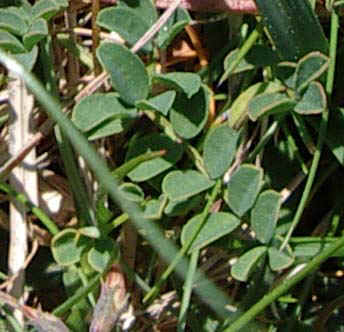 |
 |
| Pinnate.
Blunt-ended. |
Trifoliate
(two of the five leaves are bent back
so it appears trifoliate)
Elliptic (not quite circular) = Oval, ending, rounded or with a short point. |
| Pods: | Pods: |
 |
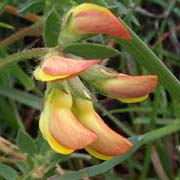 |
| Pods radiate from the top of the stem, strongly wavy, breaking up into horseshoe-shaped sections. | Cylindrical spreading out from the stem like a bird's foot. |
| Comments: | Comments: |
| Long-lived perennial | Long-lived perennial |
There
were small clumps of Horseshoe Vetch in
the cutting where the A27 by-pass cuts its way through Mill Hill
(May 2003).
Pixie
Path next to the Mill Hill Cutting (Link)
Moths:
The
micro-moth 899 Pancalia
leuwenhoekella is a notable species
that has been recorded by me.
Sussex Nature Mill Hill web page (with reports and photographs)
South
Downs (AONBs)
South
Downs: Chalk Cliffs (pic.)
View
of the downs north of Mill Hill from the River Adur valley (Link)
Coombes (the other side of the valley)
Sussex Downs Landscape: Open Chalk Escarpment
85 million years ago, Cretaceous Period (144 - 66.4 million years ago): Sussex is covered by a warm sea inhabited by ammonites, Micraster and other urchins, molluscs, at a lower latitude (Continental Drift: Tectonic Plate Theory). Sedimentary deposits of foraminiferans such as Globigerina and coccoliths (microscopic plankton with a calcium carbonate shell) lay down the chalk (Pic) which is rock of the South Downs near Shoreham.
(The slopes have been grazed but never ploughed,
and some have not been artificially seeded*)
The beginnings of the Wild Privet incursions can be seen in this image
- (*
I am beginning to think that grasses were sown a long time a go on Mill
Hill, pre-1937).
(It
is not easy to explain the steepness of the eastern and western boundaries
of the Adur Valley cutting through the South Downs north of Shoreham, although
they may have been created by melt water and weathering in periglacial
times).
Explanation
(in the course of completion: at first draft stage)
See
Devil's
Dyke South Downs site
- Geology
Page
South
Downs AONBs (Countryside Agency)
South
Downs (Friends of the Earth)
South
Downs Way
Countryside
Agency
Council
for National Parks
East
Sussex Ecology Page
Sussex downland AONBs = 981 sq. km.
Butterflies:
Small Tortoiseshell Aglais urticae Orange Tip Anthocharis cardamines Brown Argus Aricia agestis Holly Blue Celastrina argiolus Small Heath Coenonympha pamphilus Clouded Yellow Colias croceus Dingy Skipper Erynnis tages Brimstone Gonepteryx rhamni Peacock Inachis io Wall Lasiommata megera Small Copper Lycaena phlaes Adonis Blue Polyommatus bellargus Chalkhill Blue Polyommatus coridon Meadow Brown Maniola jurtina Marbled White Melanargia galathea Large Skipper Ochlodes venata Speckled Wood Pararge aegeria Large White Pieris brassicae Small White Pieris rapae Common Blue Polyommatus icarus Grizzled Skipper Pyrgus malvae Gatekeeper Pyronia tithonus Small Skipper Thymelicus sylvestris Red Admiral Vanessa atalanta Painted Lady Vanessa cardui Green-veined White Artogeia napi Small Blue Cupido minimus Essex Skipper Green Hairstreak Ringlet Brown Hairstreak Dark Green Fritillary Silver-spotted Skipper
SELECTED DISTINCTIVE SPECIES ONLY
+ 1 POSSIBLE
CLICK ON BUTTERFLIES FOR MORE33 butterfly species have been positively identified by me from Mill Hill. The Brown Argus was eventually confirmed on 7 August 2004. The Small Blue Butterfly was added to the list in 2004. The Essex Skipper and Ringlet have now been confirmed in 2015. The Green Hairstreak was seen again in April 2007 and April 2009. This makes 32.
Both the Grayling Butterfly (disappeared 1960) and the Dark Green Fritillary (disappeared 1988) have post World War II records of being common on Mill Hill, but these two butterflies do not seem to occur now. The Grayling may have been overlooked as it has been suspected on at least two occasions.
Butterflies are characteristic of the South Downs. Mill Hill, has a large population of the Chalkhill Blue, Polyommatus coridon, and the rarer but more widespread Adonis Blue, Polyommatus bellargus, with caterpillars that feed on Horseshoe Vetch.
The Common Blue caterpillar feeds on Bird's Foot Trefoil.South facing downs slopes occur to the south of the footpath from the Sussex Pad to Lancing Clump. These are important for butterflies.
NB: by 2015 this list needs revising.
Bird ListThe avian fauna of Mill Hill is surprisingly scant. The list is the course of construction (commenced January 2003):
Black-headed Gulls Variable numbers Crow Common House Sparrow Variable numbers, mostly common in scrub Kestrel Usually one (or two, the mate) present Magpie Frequent. Always present. Skylark Always present, but reduced in numbers from the 1960s. House Martin Summer Swallow Summer Blue Tit All year, noticeable in spring, near town Herring Gulls Two in April 2003. Unusual. Blackbird Lower slopes and scrub Jackdaw Common (12+) on all days in May and June 2003. January to May 2005. Whitethroat
Lesser WhitethroatHeard from the bushes, seen in autumn Yellowhammer Several records, June and July 2003 and many others. Regular Meadow Pipits A pair on 2 June 2003. Seen before and probably omnipresent. Hobby 2003 immigrant, seen only once. Willow Warbler Heard from the bushes, but rarely seen Wren in scrub on lower slopes Merlin One record Ring Ouzel Turdus torquatus Migrant. Peak month is October. Stonechat Often overlooked Robin Redbreast Lower and middle slopes Song Thrush Lower slopes Grey Heron Horse field south of the A27 Rook Occasional, becoming frequent after the small rookery in Shoreham Chiffchaff Seemed to be in many bushes in September 2004 when they can be more easily seen Long-tailed Tits Autumn and winter Great Tit April 2005 Common Partridges Occasional Tree Sparrow Winter Wheatear Passage, spring and autumn Pheasant Occasional
Tree List
Sycamore Holly Hawthorn Scrub, not fully grown trees Beech Planted Italian Alder Planted Norway Maple Planted Corsican Pine Planted Wayfaring Tree Scrub, not fully grown trees Blackthorn Scrub, not fully grown trees Elderberry Scrub, not fully grown trees Bramble Scrub, not fully grown trees Privet Scrub, not fully grown trees Dogwood Scrub, not fully grown trees
Wild Vertebrate List
Fox Roe Deer Grass Snake South-west of bridge, lower slopes Rabbit Mouse (unidentified) House or Wood or Yellow-necked ? Common Lizard Lower slopes only so far Slow Worm Lower slopes only so far
Invertebrate List
Insects (other than Butterflies):
6-spot Burnet Moth Zygaena filipendulae Red-tailed Bumblebee Bombus lapidarius Cinnabar Moth Tyria jacobaeae Buff-tailed Bumblebee Bombus terrestris Three-banded White-tail Bumblebee Bombus hortorum Hoverfly Volucella bombylans Common Carder Bee (Bumblebee) Bombus pascuorum Moth Pyrausta nigrata Solitary Bee Lasioglossum Molluscs (Slugs and Snails etc.)
VegetationOn the Coombes side (western side of the Adur valley), Elm was abundant and it still is common, reproducing by suckers, so it is not the Wych Elm, Ulmus glabra, of Saxon times but the English Elm, Ulmus procera.
le Milhouse, le Wynd Milhill 15491937 Downland (Mill Hill) donated to Shoreham by the Bridger family.
- Local
Wildlife Links (SE England)
Adur
Biodiversity Insect Links
Adur
Butterfly Image Portfolio (Smart Groups)
Adur
& the Downs: Protected Sites
Adur
Valley Nature Notes 2003
Adur
Valley Wildlife
Adur
Wildlife Image Gallery
Butterflies
of Adur
Butterflies
(Bioimages)
Butterfly
Calendar
Butterfly
Conservation Society
Chalk
& Flint Link
Chalk
& Limestone Seed Mix
Day
Flying Moths
Dungeness,
Kent, England
Grasshoppers
and Crickets (Yahoo Group)
Lancing
History & Wildlife
Lancing
Ring
Mill
Hill Images: Wildlife and Landscape
Moths
and Butterflies of Europe and North Africa
Orford
Ness: Coastal Ecology of a Shingle Bank (excellent references)
Ralph
Hollins Nature Pages (Chichester Harbour area)
Rye
Harbour Nature Reserve
Rockpooling
Page
Seashore
Page
Shingle
Coast (Coastal Fringe of Shoreham Beach)
Shoreham-by-Sea
Wildlife Page
South
Downs History (External) site
South
Downs Way (by Allen Pollard)
Southwick
Hill
Sussex
Archaeological Society
Sussex
Archaeological Society EGroup
Sussex
Archaeology & Folklore
Sussex
Wildlife Web Sites
UK
Dragonflies Discussion Group
UK-LEPS
Discussion Group (for Butterflies and Moths)
Lancing
Ring & Mill Hill Information 1 (requires Acrobat Reader)
Lancing
Ring & Mill Hill Information 2 (requires Acrobat Reader)
|
|
|
|
|
|


